Eyeballing Antique Furniture
by Bob Brooke
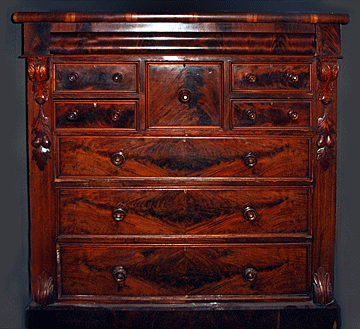 Thereís
no doubt about it. Purchasing antique furniture can be costly. And if
you donít watch out, it can leave a mighty big hole in your pocket. So
itís important to be careful and not buy a piece you think is worth
thousands of dollars, only to find out itís worth next to nothing. The
golden rule is never buy an antique until you know for sure that itís
authentic. Thereís
no doubt about it. Purchasing antique furniture can be costly. And if
you donít watch out, it can leave a mighty big hole in your pocket. So
itís important to be careful and not buy a piece you think is worth
thousands of dollars, only to find out itís worth next to nothing. The
golden rule is never buy an antique until you know for sure that itís
authentic.
Though there are a few unscrupulous antique dealers who will try to pull
one off on you, the majority are honest and just want to sell their
items as soon as possible. The longer a piece of furniture remains in
their inventory, the less profit they make on it. While a piece of
furniture may sell for more than say a cup and saucer, it takes up
valuable floor space, so thereís actually more profit in smaller items.
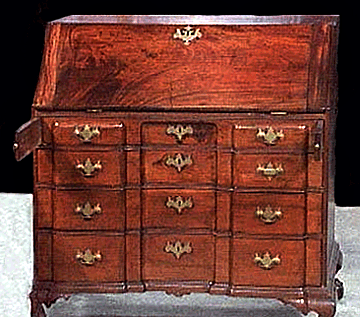 Because
dealers want to move furniture quickly, they often donít do much
research on it. Some donít look at it carefully. Of course, how high up
the retailers ladder the same venue is, the bettter chance you have of
buying an authentic piece. Generally, dealers selling at antique shows
do the most research. This is especially true of the ones selling pieces
of furniture for five and six figures. They also make sure each piece
has a provenance. Those selling out of shops do a little less research,
and it depends a lot on the type of furniture theyíre selling. Flea
market dealers do little or no research. If you buy your antique
furniture at garage and yard sales, you better know what youíre looking
at or youíre sure to be taken. Because
dealers want to move furniture quickly, they often donít do much
research on it. Some donít look at it carefully. Of course, how high up
the retailers ladder the same venue is, the bettter chance you have of
buying an authentic piece. Generally, dealers selling at antique shows
do the most research. This is especially true of the ones selling pieces
of furniture for five and six figures. They also make sure each piece
has a provenance. Those selling out of shops do a little less research,
and it depends a lot on the type of furniture theyíre selling. Flea
market dealers do little or no research. If you buy your antique
furniture at garage and yard sales, you better know what youíre looking
at or youíre sure to be taken.
So how can you tell if a piece is authentic? Believe it or not, you need
to sharpen your powers of observation. Take a lesson from Sherlock
Holmes. He wasnít just playing around with that magnifying glass.
 There
are several ways you can spot an antique. The first giveaway is the
joineryómachine-cut only dates back to 1860. If the piece has drawers,
remove a drawer and look closely where the front and back of the drawer
connects to the sides of the drawer. Not all pieces made before 1860 had
dovetail joints on drawers. Those that did had only a few, and these
weren't even. New dovetails are either machine-made or much narrower
than the wide, up-to-3/8-inch dovetails of the 1800s. Machine-cut
dovetails are precise. There
are several ways you can spot an antique. The first giveaway is the
joineryómachine-cut only dates back to 1860. If the piece has drawers,
remove a drawer and look closely where the front and back of the drawer
connects to the sides of the drawer. Not all pieces made before 1860 had
dovetail joints on drawers. Those that did had only a few, and these
weren't even. New dovetails are either machine-made or much narrower
than the wide, up-to-3/8-inch dovetails of the 1800s. Machine-cut
dovetails are precise.
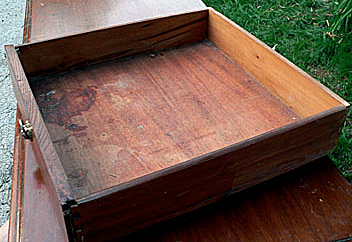 Be
sure to look carefully at the bottom, sides, and back of the drawer.
Cabinetmakers made these from solid wood, often of the same type as the
exterior of the piece. If the wood shows nicks or cuts, they probably
cut these pieces with a plane, a spokeshave, or a drawknife. Straight
saw marks also indicate an old piece. If the wood shows circular or
arc-shaped marks, you can bet the furniture maker used a circular saw,
which didnít come into use until about 1860. Be
sure to look carefully at the bottom, sides, and back of the drawer.
Cabinetmakers made these from solid wood, often of the same type as the
exterior of the piece. If the wood shows nicks or cuts, they probably
cut these pieces with a plane, a spokeshave, or a drawknife. Straight
saw marks also indicate an old piece. If the wood shows circular or
arc-shaped marks, you can bet the furniture maker used a circular saw,
which didnít come into use until about 1860.
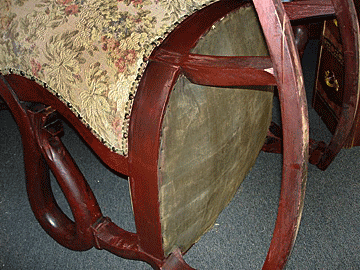 While
furniture made before 1860 may look symmetrical, if you look closely,
youíll see that it isnít. Handcrafted rungs, slats, spindles, rockers,
and other small-diameter components arenít uniform. Slight differences
in size or shape arenít always easy to spot. This is also the difference
between an authentic piece of furniture and a reproduction. The former
is hand cut while the latter is machine cut. While
furniture made before 1860 may look symmetrical, if you look closely,
youíll see that it isnít. Handcrafted rungs, slats, spindles, rockers,
and other small-diameter components arenít uniform. Slight differences
in size or shape arenít always easy to spot. This is also the difference
between an authentic piece of furniture and a reproduction. The former
is hand cut while the latter is machine cut.
Furniture finishes can help you date a piece. Before the mid-1840s,
shellac was the only clear surface finish. Lacquer and varnish didnít
come along the mid 19th century. Older pieces may have oil, wax, or milk
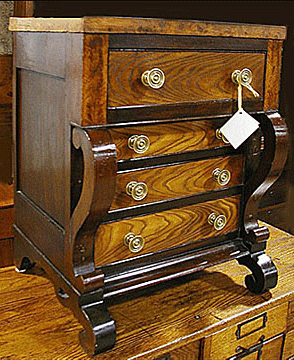 paint
finishes. Fine old pieces are often French-polished, a variation of the
shellac finish. And even though varnish may indicate a piece dates
before 1860, a lot of American Empire pieces, dating from the 1820s to
1840s, have been refinished with varnish. paint
finishes. Fine old pieces are often French-polished, a variation of the
shellac finish. And even though varnish may indicate a piece dates
before 1860, a lot of American Empire pieces, dating from the 1820s to
1840s, have been refinished with varnish.
How furniture makers joined other parts of a piece of furniture together
is another way to tell age. Generally, cabinetmakers used pegs to join
parts together. Screws didnít come into common use until the early 19th
century. Those made before 1840 had flat, un-tapered heads. Antique,
handmade screws had irregular widths between the spirals, running the
whole length of the shaft. The slot in the head was often off-center.
New screws, on the other hand, have sharp points and regular, evenly
spaced threads. And donít be fooled by what looks like a peg. It may
just be a cover glued into the hole to cover up a counter-sinked screw.
 The
wood itself is the final clue. Furniture made before 1700 is usually
oak, but after 1700, cabinetmakers commonly used mahogany and walnut.
Youíll find that most rural American pieces are of pine because farmers
made a lot of them during the cold winter months with easily found pine
wood. Generally, cabinetmakers chose harder woodsómaple, oak, walnut,
cherry, or mahogany. But these woods have always been favored for
furniture, so workmanship and finish are probably a better sign of age
than the wood itself. The
wood itself is the final clue. Furniture made before 1700 is usually
oak, but after 1700, cabinetmakers commonly used mahogany and walnut.
Youíll find that most rural American pieces are of pine because farmers
made a lot of them during the cold winter months with easily found pine
wood. Generally, cabinetmakers chose harder woodsómaple, oak, walnut,
cherry, or mahogany. But these woods have always been favored for
furniture, so workmanship and finish are probably a better sign of age
than the wood itself.
After you give a piece a good overall look, measure it to see if itís
even all around. Wood shrinks, so an older piece of furniture will most
likely have uneven measurements. Tabletops, for example, wonít be as
round as they would have been when new.
Run your hand over and shine a flashlight across the surface of the wood
to detect hairline cracks and ripples that come with aging. Look
underneath for the inevitable warping and buckling of wood.
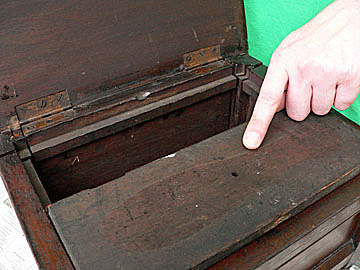 Check
to see if any of the wood has become discolored from uneven exposure to
light. An old piece of furniture that has stood against a wall for years
will show its age with distinct differences in coloring. And while itís
a good idea to check the wood beneath the hardware, most dealers wonít
allow you to detach the hardware to do so. However, if youíre able to do
so, youíll notice that the wood is usually lighter underneath. Also look
for screw holes on drawer fronts which indicate that the original
hardware has been replaced. Replaced hardware may not affect the value
of a European antique, but it can affect the value of an American one. Check
to see if any of the wood has become discolored from uneven exposure to
light. An old piece of furniture that has stood against a wall for years
will show its age with distinct differences in coloring. And while itís
a good idea to check the wood beneath the hardware, most dealers wonít
allow you to detach the hardware to do so. However, if youíre able to do
so, youíll notice that the wood is usually lighter underneath. Also look
for screw holes on drawer fronts which indicate that the original
hardware has been replaced. Replaced hardware may not affect the value
of a European antique, but it can affect the value of an American one.
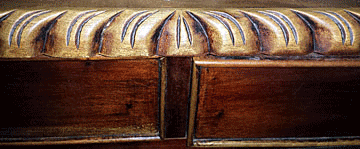 Those
who attempt to make fake antique furniture go out of their way to create
signs of wear. Search for signs of normal wear and the buildup of dust
and grime in the furniture's corners and crevices. Fakers often forget
to include the dirt build-up. Those
who attempt to make fake antique furniture go out of their way to create
signs of wear. Search for signs of normal wear and the buildup of dust
and grime in the furniture's corners and crevices. Fakers often forget
to include the dirt build-up.
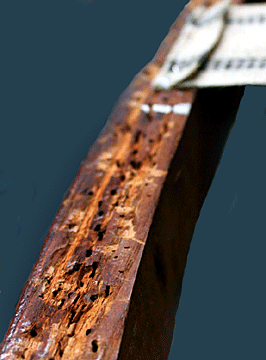 Look
at the frame under the upholstery for sets of nail holes from previous
upholstery. An aged piece may have seen several changes in fabric, so
youíll see lots of holes from previous nails. Look
at the frame under the upholstery for sets of nail holes from previous
upholstery. An aged piece may have seen several changes in fabric, so
youíll see lots of holes from previous nails.
Look carefully at the glass in mirrors to see if you can tell if it has
been replaced. Until the beginning of the 19th century, cabinetmakers
imported all the mirror glass they used. Antique glass is thinóless than
1/8 inch thickóvariably wavy, and often grayish. To determine if a piece
of mirror is old, hold the tip of a key to the glass. The closer the tip
of the reflected image is to the tip of the actual key, the more likely
it is that the glass is old.
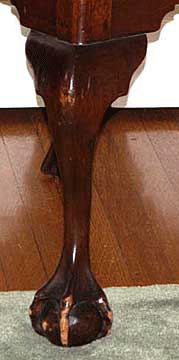 And
while youíll most likely be looking at a piece for signs of age, you
should also look for signs of newness. A thriving business in the making
of poor reproductions has developed in Indonesia. Skilled craftsmen put
as much effort into making a piece look old as they would if they were
making a fine reproduction. The difference is in the kinds of wood they
use and how they join the pieces together. And
while youíll most likely be looking at a piece for signs of age, you
should also look for signs of newness. A thriving business in the making
of poor reproductions has developed in Indonesia. Skilled craftsmen put
as much effort into making a piece look old as they would if they were
making a fine reproduction. The difference is in the kinds of wood they
use and how they join the pieces together.
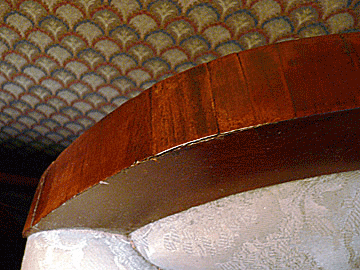 Besides
looking for the signs of age noted above, also check the edges of
furniture. Newer pieces have smoother edges and feet. Also, the feet on
newer pieces donít show the deep carving of older ones. Besides
looking for the signs of age noted above, also check the edges of
furniture. Newer pieces have smoother edges and feet. Also, the feet on
newer pieces donít show the deep carving of older ones.
Wood veneers on antique furniture are of thick and somewhat irregular
widths. Modern veneers are thin, with every slice exactly the same
width.
< Back to Collecting Archives
Next Article > |
